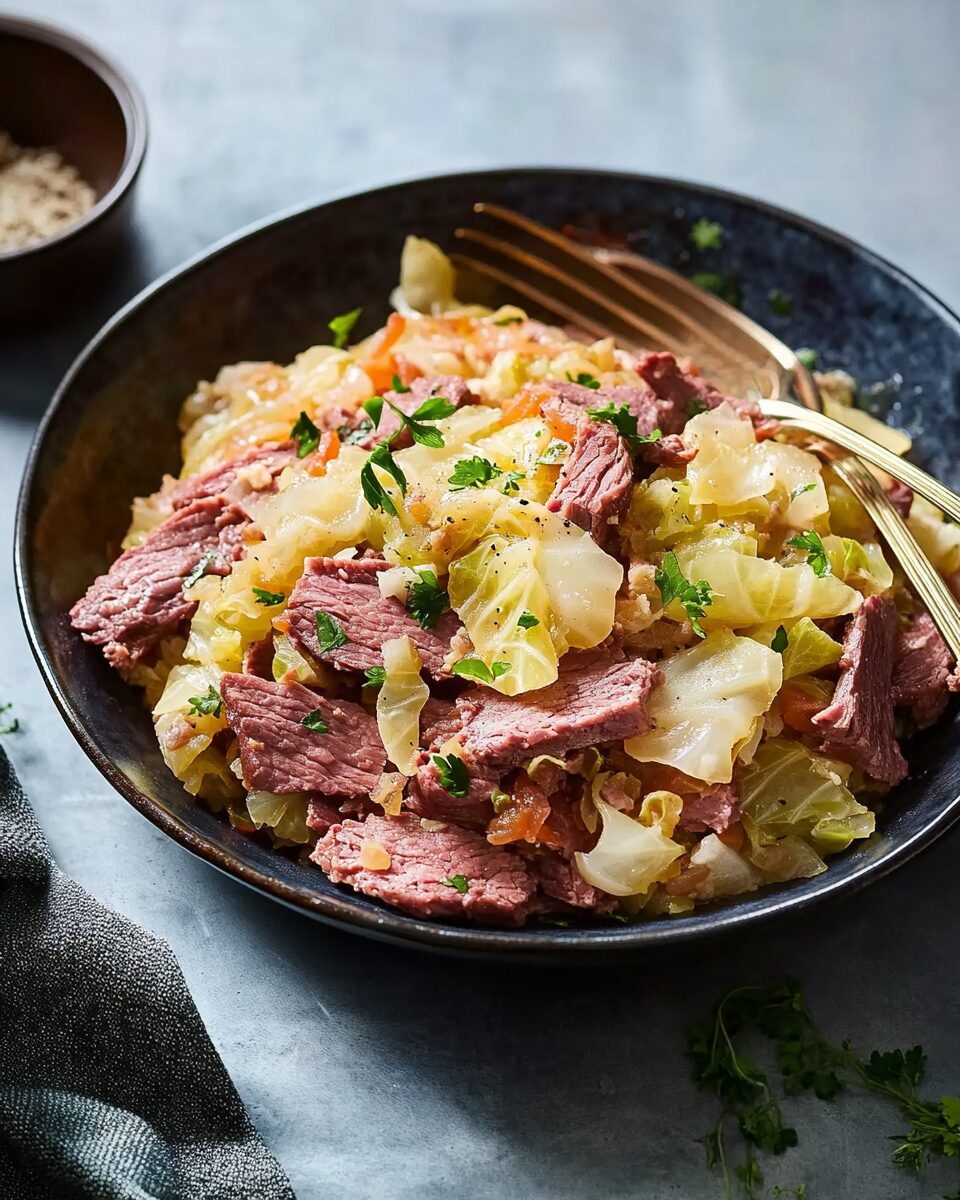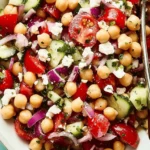This Slow Cooker Corned Beef and Cabbage recipe offers a convenient way to prepare a classic dish, making it perfect for a hearty dinner.
FULL RECIPE:
Ingredients
- 10 baby red potatoes, quartered
- 4 large carrots, peeled and cut into matchstick pieces
- 1 onion, peeled and cut into bite-sized pieces
- 4 cups water
- 1 (4-pound) corned beef brisket with spice packet
- 6 ounces beer
- ½ head cabbage, coarsely chopped
Directions
- Place potatoes, carrots, and onion into the bottom of a slow cooker; add water and place brisket on top of vegetables.
- Pour beer over brisket; sprinkle over spices from the packet and cover.
- Cook on High for 7 hours; stir in the cabbage and cook for 1 more hour.
Nutrients Per serving:
- Calories: 473
- Fat: 20g
- Carbohydrates: 50g
- Protein: 24g
History and Cultural Significance
Corned beef and cabbage is a dish often associated with Irish cuisine, particularly St. Patrick’s Day celebrations. However, its origins are deeply tied to Irish-American history rather than traditional Irish cooking. In Ireland, pork was more commonly consumed, while beef was expensive and less accessible. They paired it with cabbage, a cost-effective and widely available vegetable, creating a hearty and satisfying dish. This dish quickly became a staple in Irish-American households, particularly in cities like New York and Boston, where large Irish communities settled. Today, corned beef and cabbage is a symbol of Irish-American heritage, enjoyed not only on St. Patrick’s Day but throughout the year as a comforting and nostalgic meal.
Why Use a Slow Cooker?
One of the main reasons people prefer to prepare corned beef and cabbage in a slow cooker is convenience. The slow cooker allows the flavors to develop gradually, creating a tender and flavorful dish with minimal effort. Since corned beef is a tough cut of meat, slow cooking helps break down the connective tissues, resulting in a melt-in-your-mouth texture. Another advantage of using a slow cooker is the ability to set it and forget it. This method eliminates the need for constant monitoring, making it an ideal choice for busy individuals or those preparing meals in advance. The slow and steady cooking process also allows the vegetables to absorb the beef’s flavors, enhancing the overall taste of the dish.
Flavor Profile and Texture
Slow Cooker Corned Beef and Cabbage has a well-balanced flavor that combines the saltiness of the corned beef with the mild sweetness of the carrots and the slight bitterness of the cabbage. The beef itself has a deep, savory taste, with hints of spice from the seasoning packet typically included with the brisket. Some variations also incorporate beer, which adds complexity to the dish by enhancing its richness and providing subtle malty notes. Texture-wise, the beef becomes fork-tender after slow cooking for several hours, while the potatoes and carrots soften but retain enough firmness to provide contrast. The cabbage, added later in the cooking process, absorbs the surrounding flavors and becomes tender without turning mushy.
Variations and Additions
While the traditional recipe consists of corned beef, cabbage, potatoes, and carrots, there are numerous ways to customize the dish. Here are some variations:
- Additional Vegetables: Some people like to include parsnips, turnips, or leeks for added depth and flavor. These vegetables complement the dish’s heartiness while adding extra nutrients.
- Beer vs. Broth: Using beer instead of water enhances the richness of the broth. A stout beer, such as Guinness, adds a deep, roasted flavor, while a lager keeps the taste light. Those who prefer a non-alcoholic version can use beef or vegetable broth.
- Mustard and Horseradish: Many people serve corned beef and cabbage with a side of mustard or horseradish for an extra punch of heat and tanginess.
- Roasted or Sautéed Cabbage: Instead of cooking the cabbage in the slow cooker, some prefer to roast or sauté it separately. This method enhances its natural sweetness and provides a slightly crispy texture.
- Glazed Corned Beef: To add extra flavor, some people brush the cooked corned beef with a glaze made from brown sugar, Dijon mustard, and apple cider vinegar before broiling it for a few minutes. This creates a caramelized crust that enhances the dish’s depth.
Pairing Suggestions
Corned beef and cabbage is a hearty meal, but the right side dishes and drinks can elevate the experience.
- Bread: Serve it with traditional Irish soda bread or crusty rye bread to soak up the flavorful broth.
- Sauerkraut: A tangy side of sauerkraut enhances the salty-sweet balance of the dish.
- Mashed Potatoes: While boiled potatoes are included in the recipe, mashed potatoes can be a creamy and comforting alternative.
- Irish Beer or Whiskey: A pint of Irish stout or a glass of whiskey pairs well with the dish, complementing its richness.
- Coleslaw: A fresh, crunchy coleslaw provides a refreshing contrast to the soft textures of the slow-cooked meal.
Health Benefits
Despite being a rich and hearty dish, Slow Cooker Corned Beef and Cabbage offers several health benefits:
- Protein: Corned beef is an excellent source of protein, which helps build and repair tissues.
- Iron and B Vitamins: The beef provides essential nutrients such as iron, which supports red blood cell production, and B vitamins, which contribute to energy metabolism.
- Fiber and Vitamins from Vegetables: Cabbage, carrots, and potatoes are packed with fiber, vitamins, and antioxidants. Cabbage, in particular, contains high amounts of vitamin C and K, which support immune function and bone health.
- Gut Health: Fermented cabbage (sauerkraut) is often served as a side dish, adding probiotics that support digestive health.
Common Mistakes to Avoid
To ensure the best results when making this dish, avoid these common mistakes:
- Overcooking the Cabbage: Adding cabbage too early can result in a mushy texture. It’s best to add it during the last hour of cooking.
- Skipping the Rinse: Corned beef is heavily salted during the curing process. Rinsing the meat before cooking helps reduce excess saltiness.
- Not Cutting Against the Grain: Slicing corned beef against the grain ensures a more tender bite. Cutting with the grain can make the meat feel tough and chewy.
- Using the Wrong Type of Beer: If adding beer, avoid overly bitter varieties. A mild lager or stout works best to enhance the flavors without overpowering the dish.
Storage and Leftovers
Slow Cooker Corned Beef and Cabbage makes excellent leftovers and can be repurposed into different meals.
- Storage: Store leftovers in an airtight container in the refrigerator for up to four days. The flavors will continue to develop, making it even tastier the next day.
- Freezing: Corned beef freezes well, but cabbage and potatoes may become mushy after thawing. If freezing, store the beef separately from the vegetables.
- Reheating: Reheat in a skillet with a bit of broth to prevent drying out. Alternatively, microwave portions in a covered dish with a splash of water to retain moisture.
- Creative Uses for Leftovers: Leftover corned beef can be used in sandwiches, hash, or soups. A corned beef and Swiss cheese sandwich on rye bread with mustard is a popular option. Corned beef hash, made by frying diced potatoes, onions, and beef, is another delicious way to repurpose leftovers.
Conclusion
Slow Cooker Corned Beef and Cabbage is a dish with deep cultural roots, particularly in Irish-American cuisine. Its simplicity, combined with bold flavors and a comforting texture, makes it a favorite for special occasions and everyday meals alike. Using a slow cooker enhances the dish’s flavors while making it an effortless, hands-off recipe.






